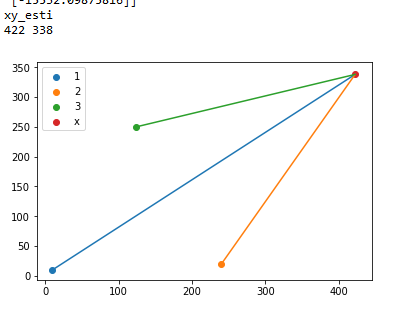TDOA 之TDOA算法python实现
这里指的TDOA算法,实际是解两个双曲线方程,由于两个二次方程设计东西较多,如果强解,计算量很大,从网上参考了如下链接:
算法推到:https://blog.csdn.net/lpsl1882/article/details/51519303
Matlab实现:https://blog.csdn.net/chenxy_bwave/article/details/86650983
我主要讲matlab 相关算法用python再次实现,后期TDOA上位机会基于Python去写
1 2 3 4 5 6 7 8 9 10 11 12 13 14 15 16 17 18 19 20 21 22 23 24 25 26 27 28 29 30 31 32 33 34 35 36 37 38 39 40 41 42 43 44 45 46 47 48 49 50 51 52 53 54 55 56 57 58 59 60 61 62 63 64 65 66 67 68 69 70 71 72 73 74 | import numpy as npimport mathimport matplotlib.pyplot as pltdef distance(x1,y1,x2,y2): dist =math.sqrt((x1-x2)*(x1-x2) + (y1-y2)*(y1-y2)) return dist x1 = 10y1 = 10x2 = 240y2 = 20x3 = 124y3 = 250x = 123y = 134# print(x1,y1,x2,y2,x3,y3,x,y)plt.scatter(x1,y1,label="1")plt.scatter(x2,y2,label="2")plt.scatter(x3,y3,label="3")plt.scatter(x,y,label="x")plt.legend()# plt.plot([x1,x],[y1,y])plt.plot([x2,x],[y2,y])plt.plot([x,x3],[y,y3])r1 = distance(x1, y1, x, y)r2 = distance(x2, y2, x, y)r3 = distance(x3, y3, x, y)print("distance")print(r1,r2,r3)r21 = r2 - r1r31 = r3 - r1print(r21,r31) x21 = x2 - x1x31 = x3 - x1y21 = y2 - y1y31 = y3 - y1print([x21, x31, y21, y31])P1_tmp = np.array([[x21,y21],[x31,y31]])print("P1_tmp:")print(P1_tmp)P1 = (-1)*linalg.inv(P1_tmp)print(P1)P2= np.array([[r21], [r31]])print("P2")print(P2)K1 = x1*x1 + y1*y1;K2 = x2*x2 + y2*y2;K3 = x3*x3 + y3*y3;print(K1,K2,K3)P3 = np.array([ [ (-K2 + K1 + r21*r21)/2], [(-K3 + K1 + r31*r31)/2 ]])print("P3:")print(P3)xy_esti = (np.dot(P1 , P2)) * r1 +np.dot( P1 , P3)print("xy_esti")#print(type(xy_esti[0]))print(int(xy_esti[0]),int(xy_esti[1])) |
运行结果截图:

标签节点无论是在三个基站组成的范围内还是范围外面,都能正确计算出结果。
以上全部执行print以及绘图,所有时间开销为:Time used: 0.0519 秒
将print 和 绘图去掉,单独计算坐标解算时间:Time used: 0.0013 秒
测试机器:Win7,CPU:E5-2670
博客讨论一些室内定位(DWM1000/CC2431/CC2530) 以及一些随性的技术。博文可以转载,但需要注明出处!




【推荐】编程新体验,更懂你的AI,立即体验豆包MarsCode编程助手
【推荐】凌霞软件回馈社区,博客园 & 1Panel & Halo 联合会员上线
【推荐】抖音旗下AI助手豆包,你的智能百科全书,全免费不限次数
【推荐】博客园社区专享云产品让利特惠,阿里云新客6.5折上折
【推荐】轻量又高性能的 SSH 工具 IShell:AI 加持,快人一步